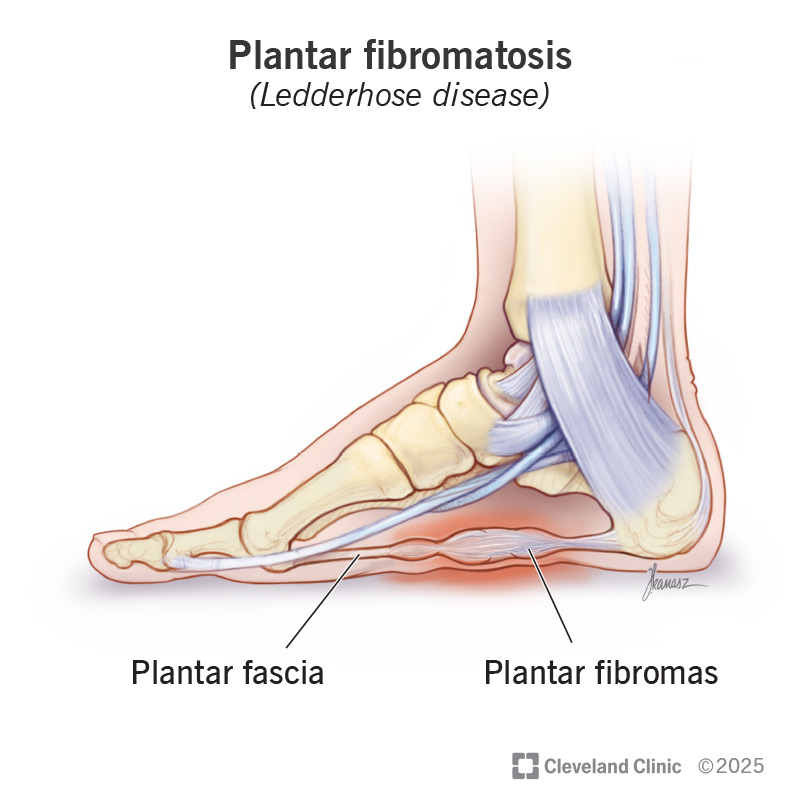Plantar fibromatosis (Ledderhose disease) is a rare condition that causes small, hard growths to develop on the bottom of your foot. These growths can be painful, and it may be difficult for you to walk. In rare cases, your toes may curl down. Treatment for plantar fibromatosis is almost always nonsurgical.
Advertisement
Cleveland Clinic is a non-profit academic medical center. Advertising on our site helps support our mission. We do not endorse non-Cleveland Clinic products or services. Policy

Plantar fibromatosis (Ledderhose disease) is a rare condition that affects your plantar fascia, the thick layer of connective tissue that protects and supports the bottom of your foot. In plantar fibromatosis (pronounced “PLANT-ter fi-broh-muh-TOH-sis”), small, hard nodules (growths) called plantar fibromas develop on the arch of your foot. They may feel like peas stuck on the inside of your shoe. These nodules grow rapidly (aggressively) to be about 1 to 2 centimeters in size.
Advertisement
Cleveland Clinic is a non-profit academic medical center. Advertising on our site helps support our mission. We do not endorse non-Cleveland Clinic products or services. Policy
While these growths are noncancerous (benign), they can become quite painful. They can affect your ability to stand or walk and may decrease your quality of life. If you develop any symptoms of Ledderhose disease, reach out to your healthcare provider. They can examine your foot and provide treatment options so you can find relief.
There are three stages to plantar fibromatosis:
Ledderhose disease causes a collection of bumps to form on the bottom of your foot. It can be uncomfortable and make it hard for you to perform your daily activities. Other plantar fibromatosis symptoms may include:
Researchers don’t know what exactly causes plantar fibromatosis. It may be related to several factors, including:
Advertisement
Ledderhose disease affects people of any age. But, it’s more common in people between the ages of 30 and 50. It’s also more common in people:
In addition, plantar fibromatosis often affects people who have certain health conditions, including:
Before examining your foot, your healthcare provider may ask several questions, including:
Your healthcare provider will then examine your foot. They’ll:
Your healthcare provider may conduct the following tests to diagnose plantar fibromatosis:
In its earliest stages, plantar fibromatosis treatment may include:
Advertisement
If your pain doesn’t decrease or stop after several months of conservative treatment, your healthcare provider may suggest:
Schedule an appointment with your healthcare provider if you:
Questions you may wish to ask your provider include:
Ledderhose disease can cause painful growths on the bottom of your feet that may continue to get worse without treatment. Fortunately, the disease doesn’t spread and isn’t life-threatening. But you should still see your provider to rule out any other conditions and seek appropriate treatment.
Though plantar fibromatosis is rare, it can be a very painful and frustrating condition to live with. As the disease progresses, you may notice it’s getting harder and harder to walk or even stand without enduring pain. Luckily, the growths involved with Ledderhose disease aren’t cancerous, but they can still affect your life in a negative way. If you’re experiencing symptoms of the condition, talk to your healthcare provider. In its earliest stages, you can treat plantar fibromatosis conservatively. In later stages, your provider may refer you to a foot and ankle specialist.
Advertisement
An aching foot or heel can bring your favorite activities to a halt. Cleveland Clinic’s foot pain experts are here to help you heal and get back on your feet.

Last reviewed on 03/12/2025.
Learn more about the Health Library and our editorial process.